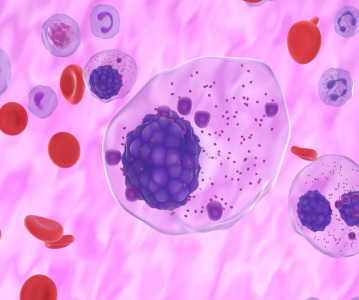Lucentis effective for proliferative diabetic retinopathy

NIH-funded clinical trial marks first major advance in therapy in 40 years.
A clinical trial funded by the National Institutes of Health (NIH) has found that the drug ranibizumab (Lucentis) is highly effective in treating proliferative diabetic retinopathy. The trial, conducted by the Diabetic Retinopathy Clinical Research Network (DRCR.net) compared Lucentis with a type of laser therapy called panretinal or scatter photocoagulation, which has remained the gold standard for proliferative diabetic retinopathy since the mid-1970s. The findings demonstrate the first major therapy advance in nearly 40 years.
“These latest results from the DRCR Network provide crucial evidence for a safe and effective alternative to laser therapy against proliferative diabetic retinopathy,” said Paul A. Sieving, director of NIH’s National Eye Institute (NEI), which funded the trial. The results were published online in the Journal of the American Medical Association.
Treating abnormal retinal blood vessels with laser therapy became the standard treatment for proliferative diabetic retinopathy after the NEI announced results of the Diabetic Retinopathy Study in 1976. Although laser therapy effectively preserves central vision, it can damage night and side vision; so, researchers have sought therapies that work as well or better than laser but without such side effects.
A complication of diabetes, diabetic retinopathy can damage blood vessels in the light-sensitive retina in the back of the eye. As the disease worsens, blood vessels may swell, become distorted and lose their ability to function properly. Diabetic retinopathy becomes proliferative when lack of blood flow in the retina increases production of a substance called vascular endothelial growth factor, which can stimulate the growth of new, abnormal blood vessels. These new vessels are prone to bleeding into the center of the eye, often requiring a surgical procedure called a vitrectomy to clear the blood. The abnormal blood vessels can also cause scarring and retinal detachment. Lucentis is among several drugs that block the effects of vascular endothelial growth factor.
The DRCR.net enrolled 305 participants (394 eyes) with proliferative diabetic retinopathy in one or both eyes at 55 clinical sites across the country. Eyes were assigned randomly to treatment with Lucentis or laser. For participants who enrolled both eyes in the study, one eye was assigned to the laser group and the other was assigned to the Lucentis group. About half of the eyes assigned to the laser group required more than one round of laser treatment. In the other group, Lucentis (0.5 mg/0.05 mL) was given via injections into the eye once per month for three consecutive months, and then as needed until the disease resolved or stabilized.
Because Lucentis is commonly used to treat diabetic macular edema — the build-up of fluid in the central area of the retina — the study permitted the use of Lucentis for diabetic macular edema in the laser group, if necessary. Slightly more than half (53%) of eyes in the laser group received Lucentis injections to treat diabetic macular edema. About 6% of eyes in the Lucentis group received laser therapy, mostly to treat retinal detachment or bleeding.
At 2 years, vision in the Lucentis group improved by about half a line on an eye chart compared with virtually no change in the laser group. There was little change in side vision with injection (average worsening of 23 decibels) but a substantial loss of side vision with laser (average worsening of 422 decibels). The vitrectomy rate was lower in the Lucentis group (8 of 191 eyes) than in the laser group (30 of 203 eyes).
Rates of serious systemic adverse events, including cardiac arrest and stroke, were similar between the two groups. One patient in the Lucentis group developed endophthalmitis, an infection in the eye. Other side effects were low, with little difference between treatment groups.
“Lucentis should be considered a viable treatment option for people with proliferative diabetic retinopathy, especially for individuals needing anti-vascular endothelial growth factor for diabetic macular edema,” said Jeffrey G. Gross, of the Carolina Retina Center in Columbia, South Carolina, who chaired the study. Dr Gross presented results 13 November 2015, at the annual meeting of the American Academy of Ophthalmology in Las Vegas.
In addition to treating proliferative diabetic retinopathy, the report suggests Lucentis may even help prevent diabetic macular edema from occurring. Among people without diabetic macular edema at the start of the study, only 9% of Lucentis-treated eyes developed diabetic macular edema during the study, compared with 28% in the laser group. The DRCR.net will continue to follow patients in this study for a total of 5 years.
Related News
-
News BioNTech to begin mRNA vaccine manufacturing in Rwanda by 2025
German biotechnology company BioNTech has stated their intentions to begin production at their mRNA vaccine factory in Rwanda by 2025, which will mark the first foreign mRNA vaccine manufacturing site on the continent of Africa. -
News Identifying Alzheimer’s Disease biomarker proteins with whole blood tests
A University of Manchester spin-out pharmaceutical company, PharmaKure, has reported successful study results for the quantification of Alzheimer’s Disease biomarker proteins with a whole blood test. -
News Bill & Melinda Gates Foundation to boost mRNA vaccine initiatives in Africa with USD $40m
To address vaccine inequality and accessibility issues, the Bill & Melinda Gates Foundation aims to deliver USD $40m to various biotech companies and vaccine manufacturers in support of mRNA vaccine development. -
News CPHI Podcast Series: Exploring neurological frontiers in Alzheimer's and beyond
The next episode of the CPHI Podcast Series delves into the science and background behind some recent developments in the field of Alzheimer's disease and neurological disorders. -
News Is patient centricity the future of pharmaceutical manufacturing?
In this interview with Sandra Sánchez y Oldenhage, President of PharmAdvice, she speaks to the importance of considering patients in the manufacturing stages of the pharmaceutical supply chain, and how it can redefine healthcare. -
News CPHI Podcast Series: How to leverage AI for Drug Discovery
Artificial intelligence is the topic of debate in the latest episode from the CPHI Podcast Series, where Digital Editor Lucy Chard speaks with Bill Whitford of DPS Group about the integration of AI in healthcare. -
News Pfizer forges ahead with blood cancer therapy after approval from FDA
Pfizer gains accelerated approval from the US FDA for their new bispecific antibody therapy for multiple myeloma, set to address an unmet need for patients. -
News Alzheimer's drug donanemab deemed effective in landmark clinical trial
Results from the TRAILBLAZER-ALZ 2 Randomised Clinical Trial into the use of donanemab to treat early symptoms of Alzheimer’s disease have been analysed.
Position your company at the heart of the global Pharma industry with a CPHI Online membership
-
Your products and solutions visible to thousands of visitors within the largest Pharma marketplace
-
Generate high-quality, engaged leads for your business, all year round
-
Promote your business as the industry’s thought-leader by hosting your reports, brochures and videos within your profile
-
Your company’s profile boosted at all participating CPHI events
-
An easy-to-use platform with a detailed dashboard showing your leads and performance







